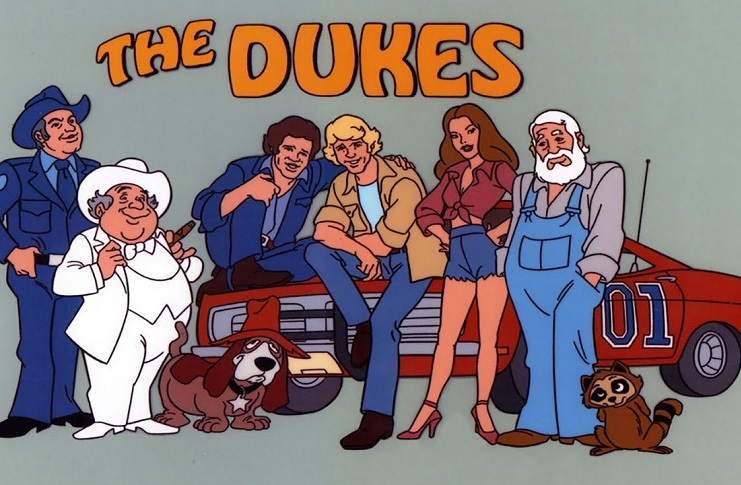
Welcome to Part 2 of my examination of cartoons based on live-action shows! In Part 1, I discussed the first such program, The Brady Kids, as well as those that followed it throughout the 1970s — Lassie’s Rescue Rangers, The Addams Family, Jeannie, My Favorite Martians, Star Trek, Emergency +4, The New Adventures of Gilligan, The Partridge Family 2200 AD, and The Oddball Couple, as well as Gilligan’s Planet, even though that aired in the 1980s. (I have also since discovered that there was a cartoon based on Lost in Space that aired in the ’70s, but I may cover that by itself later.) Now let’s take a look at some other shows that aired in the 1980s.
Kicking off the decade was The Fonz and the Happy Days Gang, based on the pop culture phenomenon Happy Days. The hit sitcom, created by the legendary Garry Marshall, ran from 1974-1984 for 11 seasons, topping the Neilsen ratings, spawning dozens of catchphrases, and selling loads of merchandise. Nowadays, the black leather jacket worn by Henry Winkler as Arthur “The Fonz” Fonzerelli hangs in the Smithsonian Institute.
Happy Days was a crossover hit that appealed to viewers of all ages including kids. The series even spawned a line of toys by Mego, so it was a no-brainer to transport the property to animation on Saturday mornings.
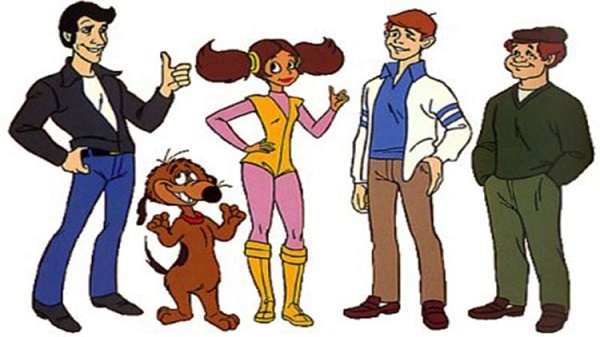
The Fonz and the Happy Days Gang premiered on ABC in the fall of 1980. The cartoon was produced by Hanna-Barbera and the live-action actors from Happy Days voiced their cartoon counterparts — Winkler as The Fonz, Ron Howard as Richie Cunningham, and Donny Most as Ralph Malph. Unfortunately, those were the only characters from the sitcom used on the ‘toon.
Then again, the cartoon had nothing to do with the live-action source. In the animated series, Fonz, Richie, and Ralph, accompanied by Fonz’s anthropomorphic dog, Mr. Cool (Frank Welker), encounter a time traveler from the future named Cupcake. They then accompany her on time-hopping adventures through various eras.
Cupcake was voiced by Didi Conn, best known for starring in another retro hit of the ’70s, as Frenchie in Grease.
The Fonz and the Happy Days Gang Season 1 contained 13 episodes, while Season 2 consisted of 11. The series ended after that and The Fonz/Winkler and Mr. Cool/Welker were then moved over to Laverne & Shirley in the Army‘s second season.
The entire series of The Fonz and the Happy Days Gang was released on DVD in 2019.
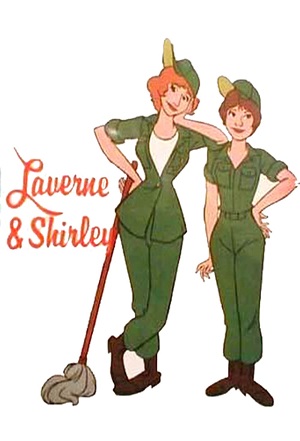
The live-action Happy Days was such a hit that it spawned multiple spinoffs, also produced by Marshall, starting with Laverne & Shirley, which began in 1976 and continued until 1983. Another, more unlikely spinoff was Mork & Mindy about a super-powered alien attempting to blend into American culture based on a character that Richie encountered in a fever dream on an episode of Happy Days.
Similarly, The Fonz and the Happy Days Gang inspired the creation of cartoons inspired by Laverne & Shirley and Mork & Mindy.
Based on the two-part 1979 episode of the live-action series, “We’re in the Army Now,” Laverne & Shirley in the Army began airing in 1981, paired with Season 2 of Fonz and the Happy Days Gang. As with The Fonz, the live-action actors lent their pipes to their animated characters with Penny Marshall (sister of Garry) as Laverne DeFazio, and Cindy Williams as Shirley Feeney. Williams however was unhappy and planned to leave both the live-action and animated shows. Producers managed to talk her into staying with the live-action series, and part of the agreement was that she no longer had to voice the cartoon, so Lynne Marie Stewart took over the role for Season 2.
The cartoon, as you could probably guess by the full title, involved the Milwaukee-based brewers enlisting in the army. Their tough drill sergeant, an actual talking pig, Sgt. Squeally was voiced by another star of a 1970s hit sitcom, Ron Palillo, who had played the dimwitted Arnold Horshack on Welcome Back Kotter.
Like Fonz and the Happy Days Gang, Laverne & Shirley in the Army was produced by Hanna-Barbera. The first season consisted of 13 episodes. Eight episodes were added for Season 2. The first season is available as a DVD on demand from CBS Home Entertainment and Paramount Home Entertainment.
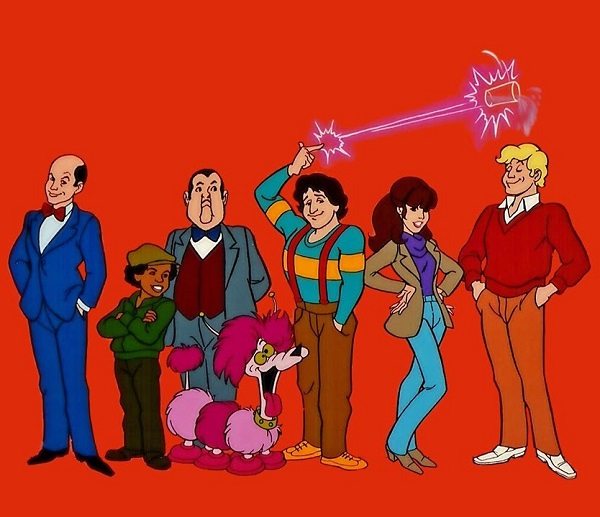
Mork from Ork was an alien that Richie Cunningham encountered in a fever dream in the 1978 Happy Days episode “My Favorite Orkan,” the title inspired by the 1960s sitcom My Favorite Martian. Believe it or not, the creators of Happy Days inserted an alien into an episode in response to the phenomenon that was Star Wars, which had taken the world by storm in the summer of 1977.
The reaction to the character of Mork was so overwhelmingly positive that producers decided to bring the character back in his own show. The role was famously originated by the now legendary Robin Williams and was his big break. This sitcom was removed from Happy Days as it was set in the “present” (the 1970s-80s) of Boulder, Colorado. Ultimately, Mork & Mindy lasted for four seasons, from 1978-81.
Pam Dawber co-starred as Mindy McConnell, Mork’s roommate, and Earth tour guide. Eventually, of course, the two fell in love.
After Fonz and the Happy Days Gang ended in 1982, ABC replaced it with the Mork & Mindy cartoon, which was paired with Season 2 of Laverne & Shirley in the Army. (The Fonz still got billing as his character was now featured on L&S.) The Mork & Mindy cartoon was a prequel to the sitcom, as Mindy was a teenager in high school. Like the previous two shows, the live-action cast voiced their animated characters — Williams as Mork, Dawber as Mindy, and Conrad Janis as Mindy’s father, Frederick. Also reprising his role was Ralph James as Orson, Mork’s never-seen superior on the planet Ork. On the cartoon, Mork is accompanied by an Orkan dog, Doing (rhymes with “Boing”) voiced by Frank Welker.
There was only one season of Mork & Mindy but it was twice as long as those of most shows with 27 episodes. (The last episode was pre-empted by the Tournament of Roses Parade and it is unknown whether it ever actually aired.)
The Mork & Mindy cartoon was a joint venture between Hanna-Barbera and Ruby-Spears Enterprises.
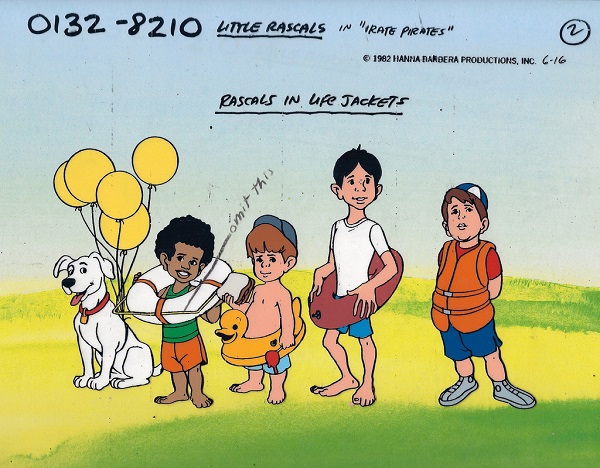
Technically, The Little Rascals wasn’t created for TV. The original Hal Roach-created shorts were shown in theaters, but from the dawn of the TV age, The Little Rascals (also known as Our Gang) was a popular feature packaged for kids’ entertainment. The appeal of these precoscious ragamuffins endured through the decades, although most people nowadays are more familiar with the live-action theatrical movie from the 1990s.
In 1982, Hanna-Barbera released an animated Little Rascals series which aired for two seasons from 1982-83. Like the live-action version, the first season episodes were composed of two shorts plus a 30-second vignette. There were 13 episodes in the first season. The nine episodes in the second season were full 30-minute stories.
The major difference between the cartoon and the live-action shorts was the time setting, as the animated version was set in the present of the ’80s.
Peter Cullen (Optimus Prime) voiced Pete the Pup and Officer Ed, with Patty Maloney as Darla Hood, Julie McWhirter as Alfalfa, Porky, and The Woim, Scott Menville as Spanky, Shavar Ross as Buckwheat, and B.J. Ward as Butch and Waldo.
In 1984, after the cartoon had ceased production, Eugene Lee, who played Porky in the original Little Rascals sued Hanna-Barbera for using his likeness. George McFarland (Spanky), Tommy Bond (Butch), and Sidney Kibrick (The Woim) wound up joining him in his lawsuit. (The rest of the cast was deceased by this time.) The court determined that Hanna-Barbera’s license with King World did not, in fact, include the right to use the actors’ likenesses and the animator settled out of court.
Plans to release the animated Little Rascals via Warner Archive were abandoned due to reasons beyond Warner Bros.’ control. If I had to guess, it is probably due to the earlier lawsuit.
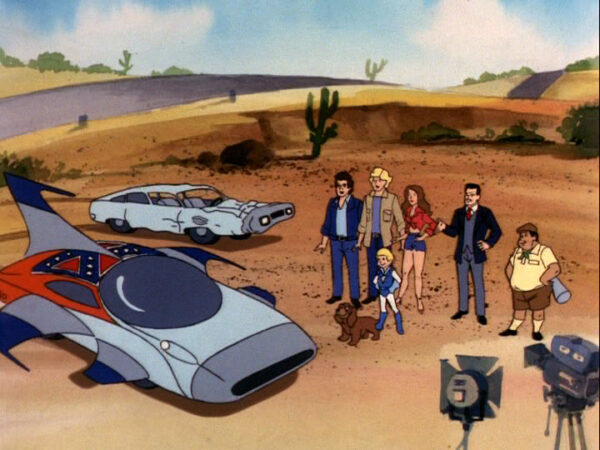
Another primetime series that became a huge sensation was The Dukes of Hazard. This country-fried action-comedy hit the scene in 1979, riding the wave of rural entertainment that was popular at the time. Its stars, John Schneider (who played Bo Duke), Tom Wopat (Luke Duke), and Catherine Bach (Daisy Duke) became sex symbols, and loads of merchandise was released. The show appealed to a broad demographic and that included kids. Various toys were released based on the series and, of course, a cartoon spinoff was created.
HOWEVER, there was a snag. After a dispute over royalties, Schneider and Wopat quit after the fourth season. Producers simply tried to replace them, bringing in their lookalike “cousins” Coy (played by Byron Cherry) and Vance (Christopher Mayer). Unfortunately, it was during this time that The Dukes cartoon was first created, so the first season featured Coy and Vance, not Bo and Luke.
Like the previously discussed shows, The Dukes was produced by Hanna-Barbera. It aired on CBS, the same network that carried The Dukes of Hazard in 1983. The live-action cast provided their counterparts’ voices — Cherry as Coy, Mayer as Vance, Bach as Daisy, Denver Pyle as Uncle Jesse, James Best as Sherriff Rosco P. Coltrane, and Sorrell Booke as Boss Hogg. On the live-action series, Rosco had a dog named Flash, who also appeared on the cartoon, but was more anthropomorphic and was voiced by Frank Welker.
On The Dukes, the main characters ventured out of their native Hazard County, Georgia to participate in a race around the world. Coy, Vance, and Daisy traveled in their famous orange 1969 Dodge Charger, the General Lee, in hopes of winning the money needed to save their family farm. Boss Hogg and Rosco competed against them to both thwart their attempt to save their farm and to win the prize money for themselves. Shockingly, the cartoon completely omitted the fact that the Dukes were moonshine bootleggers. Wonder why?
After ratings on The Dukes of Hazard tanked following Scheider and Wopat’s departure, the network and two stars reached a settlement, and Schneider and Wopat returned to their roles. Coy and Vance were never seen, heard from, or even mentioned again. The second season of The Dukes also ditched the replacements and Scheider and Wopat lent their voices to the animated versions of Bo and Luke.
There were the typical 13 episodes in Season 1 and only 7 in Season 2, so unlike The Dukes of Hazard, Coy and Vance actually made more appearances than Bo and Luke on The Dukes.
The entire series of The Dukes is available as a DVD on demand from Warner Archives.
Shows like Happy Days, Laverne & Shirley, and The Dukes of Hazard weren’t really made for children. They were made for adults, but kids just happened to like them. (I’d say Mork & Mindy was perhaps a bit more kid-skewing.) But in 1984, NBC began broadcasting a sitcom that was clearly targeted at the youth market– Punky Brewster.

Punky Brewster starred the precocious Soleil Moon Frye as the titular character, a little girl who is abandoned by her parents and taken in by the elderly widower Henry Warnimont (George Gaynes). Punky is constantly accompanied by her dog, Brandon. The show also featured Punky’s friends Cherie (Cherie Johnson), and Allen (Casey Ellison), as well as rich mean girl Margaux (Ami Foster).
The live-action show was a hit with its target audience, but it was no match for its competition, CBS’ powerhouse new program 60 Minutes. But to further fuel the Punky Brewster brand, NBC adapted it into a Saturday morning cartoon.
Technically, the animated version is called It’s Punky Brewster, but the “It’s” never appeared on the program itself or in TV listings. But that was its title behind the scenes.

This cartoon was produced by Ruby-Spears Productions and, of course, it aired on NBC, the same network that hosted the live-action iteration. Like with many of the other shows, the live-action cast voiced their cartoon counterparts with Frye as Punky, Gaynes as Henry, Johnson as Cherie, Ellison as Allen, and Foster as Margaux. Brandon’s barks were provided by Frank Welker, who also provided his speaking voice in the episode “Brandon the Dialogue Dog.”
What truly separated the cartoon from the live-action show was the presence of Glomer, a furry leprechaun-like creature with magical powers who would take the kids on adventures. Welker provided Glomer’s voice. A running theme throughout the series was the desire to return Glomer to his magical homeland, something that could only be accomplished by finding a portal at the end of a rainbow. Sadly, like most cartoons, It’s Punky Brewster never got a proper ending, so… guess he’s still stuck in our world.
It’s Punky Brewster lasted for two seasons, each consisting of 13 episodes. It’s fairly uncommon for a cartoon series to get a second season with a full batch of new episodes, so clearly this program was pretty popular. It ran from 1985-87.
The live-action Punky Brewster lasted for four seasons, wrapping up its run in 1988. There were 22 episodes in each season. Just last year, a revival series, featuring an adult Punky, was released via Peacock but canceled after one season.
The animated Punky Brewster episodes were released as bonus features on the DVD releases of the live-action series. However, due to music rights issues, the episode “The Shoe Must Go On” was not included as it featured the song “Axl F” by Harold Faltermeyer (a.k.a the theme song from Beverly Hills Cop).

Another NBC series that was also clearly aimed at a kid/family audience was 1986’s ALF, which featured the Alien Life Form also known as Gordon Shumway from the planet Melmac. ALF was a puppet controlled by Paul Fusco, the co-creator of the series. Fusco also provided his voice.
On the sitcom, following the destruction of his homeworld, ALF crashed his spaceship into the garage of the suburban family the Tanners, who take him in and spend the majority of the series struggling to keep his presence a secret. All the while, ALF made it his mission to eat the family’s cat.
Sure enough, ALF was a hit right out of the gate and in 1987, NBC unleashed an ALF animated series on Saturday mornings. This series was produced by DIC and was set prior to the events of the sitcom, on Melmac prior to its destruction. As such, the lead character is never called “ALF” but is referred to by his real name “Gordon.”
The series followed Gordon and his family and friends in their day-to-day domestic exploits. Gordon’s family consisted of his father Bob (Thick Wilson), a bumbling inventor, mother Flo (Peggy Mahon), little brother Curtis (Michael Fantini), and little sister Augie (Paulina Gillis). Also featured were their pets, the dog Neep, and Harry the bird. Gordon also spent time with his girlfriend Rhonda (Gillis), and buddies Skip (Rob Cowan) and Rick (Fusco).
The ALF cartoon was so successful that NBC launched a spinoff in 1988, ALF Tales, which recast the characters from the main cartoon in famous fairy tales, fables, and legends.
The main ALF cartoon lasted for two seasons, which, like Punky Brewster, included 13 full episodes each. The first season of ALF Tales contained 13 episodes, but there were only eight in the second. Both animated series ended in 1989.
In 2006, a DVD boxed set containing some episodes of both ALF and ALF Tales was released. Some episodes are also included as extras on the DVD releases of the live-action ALF series.
The animated series is technically just called “ALF” like the live-action sitcom, but nowadays, many refer to it as “ALF: The Animated Series” to differentiate them.

Another puppet show that got turned into an animated series was Fraggle Rock. The original Fraggle Rock was created by Jim Henson. It aired on HBO in the U.S. for five seasons beginning in 1983 and ending in 1987. It was a huge hit, but HBO is a premium channel, so not everyone was exposed to it.
In 1987, an animated version was created by Marvel Productions, who had previously produced the Emmy Award-winning Muppet Babies, also based on a Henson property. The wider exposure is the only reason I can think of as to why this cartoon was made, as there isn’t that much of a difference between a puppet show and an animated one to kids.
When it originally aired, the puppet version of Uncle Traveling Matt appeared in “bookend” segments, but those were cut out when the show was later rerun on The Disney Channel and replaced by an animated version.
The puppeteers/performers from the original did not reprise their roles on the cartoon. Instead, the animated cast consisted of Bob Bergen as Wembley, Townsend Coleman as Gobo, Barbara Goodson as Red, Mona Marshall as Mokey, and Rob Paulsen as Boober. Later on, Patrick Pinney was added as Uncle Traveling Matt.
Some episodes were full 30-minute stories, while others featured two 15-minute shorts. The animated version of Fraggle Rock only lasted for one 13-episode season. It is available on DVD and Blu-Ray.

The final show on this list isn’t actually based on a live-action show, per se, but The Completely Mental Misadventures of Ed Grimley is based on a character created by and portrayed by Martin Short when he was a cast member of first SCTV and later Saturday Night Live. The character is a hyperactive manchild who plays the triangle, dances erratically, and is socially awkward, though not really aware of that.
The episodes typically begin fairly mundane, with Ed winding up on surreal adventures as things progress. Also surreal were the inclusions of science lessons courtesy of The Amazing Gustav Brothers (Roger and Emil) and a live-action segment called Count Floyd’s Scary Stories, with a horror host played by Short’s SCTV costar Joe Flaherty.
In fact, SCTV had a heavy presence on this show with many alumni lending their voices including Andrea Martin as Deidre, the wife of Ed’s landlord, Leo (voiced by the great Jonathan Winters), and Catherine O’Hara as neighbor Ms. Malone. Christopher Guest, Eugene Levy, and Dave Thomas made guest appearances. In addition, Danny Cooksey (Diff’rent Strokes) voiced Ms. Malone’s young brother Wendell, and Frank Welker voiced the rat, Sheldon.
To my knowledge, this is all of the cartoons based on live-action cartoons from the 1980s. There was one that I know of from the 1990s, which I will cover later. (Do you know what it was?)
Are you a fan of any of these cartoons?



